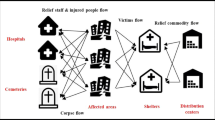Abstract
Managers recognize that a strong relation prevails between the location of facilities; the allocation of suppliers, vehicles, and customers to the facilities; and in the design of routes around the facilities. To integrate strategic, tactical, and operational decisions, a multi-objective dynamic stochastic programming model is proposed for a humanitarian relief logistics problem where decisions are reached for pre- and post-disaster. The model features three objectives: minimizing the maximum amount of shortages among the affected areas in all periods, the total travel time, and sum pre- and post-disaster costs. The first objective pursues fairness—expending the best effort to ensure relief commodity delivery to all demand points—whereas the two other objectives pursue the efficiency goal. The proposed model is solved as a single-objective mixed-integer programming model applying the ε-constraint method. A case study is presented to illustrate the potential applicability of our model for disaster planning of earthquake scenarios in the megacity of Tehran. The findings demonstrate that the proposed model can benefit making decisions on facility location, resource allocation, and routing decisions in cases of disaster relief efforts.
Similar content being viewed by others
References
Lin Y-H, Batta R, Rogerson P, Blatt A, Flanigan M (2012) Location of temporary depots to facilitate relief operations after an earthquake. Socio Econ Plan Sci 46(2):112–123
Afshar A, Haghani A (2012) Modeling integrated supply chain logistics in real-time large-scale disaster relief operations. Socio Econ Plan Sci 46(4):327–338
Balcik B, Beamon BM, Smilowitz K (2008) Last mile distribution in humanitarian relief. J Intell Transportation Syst: Technol Plann Oper 12(2):51–63
Barbarosoglu G, Arda Y (2004) A two-stage stochastic programming framework for transportation planning in disaster response. J Oper Res Soc 55:43–53
Bozorgi-Amiri A, Jabalameli MS, Alinaghian M, Heydari M (2012) A modified particle swarm optimization for disaster relief logistics under uncertain environment. Int J Adv Manuf Technol 60:357–371
Haghani A, Oh SC (1996) Formulation and solution of a multi-commodity, multi-modal network flow model for disaster relief operations. Transportation Res Part A 30(3):231–250
Akkihal A (2006) Inventory pre-positioning for humanitarian operations. Thesis for Degree of Master of Engineering in Logistics, MIT CTL
Tzeng GH, Cheng HJ, Huang TD (2007) Multi-objective optimal planning for designing relief delivery systems. Transp Res E 43(6):673–686
Dantzig GB, Ramser JH (1959) The truck dispatching problem. Manag Sci 6(1):80–91
Toth P, Vigo D (eds) (2001) The vehicle routing problem. SIAM monographs on discrete mathematics and applications. Society for Industrial & Applied Mathematics, Philadelphia
Laporte G (1992) The vehicle routing problem: an overview of exact and approximate algorithms. Eur J Oper Res 59(3):345–358
Barbarosoglu G, Ozdamar L, Cevik A (2002) An interactive approach for hierarchical analysis of helicopter logistics in disaster relief operations. Europe J Oper Res 140:118–133
Ozdamar L, Ekinci E, Kucukyazici B (2004) Emergency logistics planning in natural disasters. Ann Oper Res 129(1–4):217–245
Zhu J (2011) Supply allocation and vehicle routing problem with multiple depots in large-scale emergencies. Burak Eksioglu (Ed). 75
Lin Y-H, Batta R, Rogerson P, Blatt A, Flanigan M (2011) A logistics model for emergency supply of critical items in the aftermath of a disaster. Socio Econ Plan Sci 45(4):132–45
Najafi M, Eshgi K, Dullaert W (2013) A multi-objective robust optimization model for logistics planning in the earthquake response phase. Transport Res Part E: Logistics Transport Rev 49(1):217–249
Min H, Jayaraman V, Srivastava R (1998) Theory and methodology combined location-routing problems: a synthesis and future research directions. Eur J Oper Res 108:1–15
Yi W, Ozdamar L (2007) A dynamic logistics coordination model for evacuation and support in disaster response activities. Europe J Oper Res 179:1177–1193
De Angelis V, Mecoli M, Nikoi C, Storchi G (2007) Multi-period integrated routing and scheduling of World Food Program cargo planes in Angola. Comput Oper Res 34(160):1–15
Ukkusuri S, Yushimito W (2008) Location routing approach for the humanitarian prepositioning problem. Transp Res Rec 2089:18–25
Rath S, Gutjahr WJ (2011) A math-heuristic for the warehouse location–routing problem in disaster relief. Comput Oper Res. DOI: 10.1016/j.cor.2011.07.016
Jia H, Ordonez F, Dessouky M (2007) Solution approaches for facility location of medical supplies for large-scale emergencies. Comput Ind Eng 52(2):257–276
Balcik B, Beamon BM (2008) Facility location in humanitarian relief. Int Logistic Res Appl 11(2):101–121
Salmeron J, Apte A (2010) Stochastic optimization for natural disaster asset prepositioning. Prod Oper Manag 19(5):561–574
Rawls CG, Turnsquist MA (2010) Pre-positioning of emergency supplies for disaster response. Transport Res Part B Methodol 44(4):521–534
Mete ON, Zabinsky Z (2010) Stochastic optimization of medical supply distribution. Int J Prod Econ 126:76–84
Rawls CG, Turnquist MA (2011) Pre-positioning planning for emergency response with service quality constraints. OR Spectr 33:481–498
Rawls CG, Turnquist MA (2012) Pre-positioning and dynamic delivery planning for short-term response following a natural disaster. Socio Econ Plan Sci 46(1):46–54
Bozorgi-Amiri A, Jabalameli SMJ, Al-e-Hashem M (2013) A multi-objective robust stochastic programming model for disaster relief logistics under uncertainty. OR Spectr 35:905–933
Zhan Sh, Liu N, Ye Y (2013) Coordinating efficiency and equity in disaster relief logistics via information updates. Int J Syst Sci. DOI:10.1080/00207721
Lu C, Sheu J (2013) Robust vertex p-center model for locating urgent relief distribution centers. Comput Oper Res 40(8):2128–2137
Najafi M, Eshgi K, Leeuw Sd (2013) A dynamic dispatching and routing model to plan/ re-plan logistics activities in response to an earthquake. OR Spectrum. DOI: 10.1007/s00291-012-0317-0
Mavrotas G (2009) Effective implementation of the ε-constraint method in Multi-Objective Mathematical Programming problems. Apply Math Comp 213(2):455–465
Berberian M, Yeats RS (2001) Contribution of archaeological data to studies of earthquake history in the Iranian plateau. J Struct Geol 23:563–584
Japan International Cooperation Agency (JICA) (2000) The study on seismic micro-zonation of the Greater Tehran Area in the Islamic Republic of Iran, Final Report
Author information
Authors and Affiliations
Corresponding author
Rights and permissions
About this article
Cite this article
Bozorgi-Amiri, A., Khorsi, M. A dynamic multi-objective location–routing model for relief logistic planning under uncertainty on demand, travel time, and cost parameters. Int J Adv Manuf Technol 85, 1633–1648 (2016). https://doi.org/10.1007/s00170-015-7923-3
Received:
Accepted:
Published:
Issue Date:
DOI: https://doi.org/10.1007/s00170-015-7923-3




